<!--#easybanner-->
Bonnie Boat to Skye
Words and pictures by Stuart
Cameron

|
Waverley's restored wooden
'fanboards' (destination boards) confirmed to the
sizeable queue that had formed in the sunshine on the
North Pier at Oban that this 'bonnie boat' was indeed
bound for the legendary Isle of Skye but in this case
Glasgow's 'mighty paddler' would be sailing via the Sound
of Mull to the southern tip of the Sleat peninsula and
would not, as far as we knew, be carrying any Pretenders
to the throne - young or old. So it was a happy
crowd of over 400 that were aboard as Waverley swept
under the twin sentinels of the monument to David
Hutchison, a pioneer of the highland steamboat trade, on
Kerrera's northern tip and the ancient castle ramparts of
Dunollie on the Lorn shore. We were sad to hear, however,
that many more intending passengers from Glasgow had been
very disappointed when a problem related to the special
coaches that had been hired to convey them north from the
city had prevented them from joining the ship at Oban. We
could well imagine their disappointment and hoped that
Waverley would get the opportunity to redress that in
future. |
| Waverley passed close under the
ramparts of Duart Castle on the Isle of Mull, closer than
I have seen it from the see before and received a
welcoming whistle from one of the little steam
locomotives on the light railway that runs from Mull's
main ferry port at Craignure to the nearby Torosay
Castle. The paddler's own steam whistle was exercise in a
traditional reply. Passing up the Sound of Mull the
bright sunshine of Oban disappeared under a cloud bank
but it was to reappear later in the day. However, the
photos of Waverley passing the old steamer calling places
at Lochaline, Salen and Drimnin were probably not as
bright as the photographers would have wished. |

|
Despite a delay in leaving Oban, Waverley turned into
the deep sheltered bay of the Well of Mary (Tobermory) a little
ahead of schedule. Tobermory has always had a soft spot for
Waverley, ever since her first call one glorious sunny day in
April 1983. Perhaps its because Waverley made that first visit at
a time when the future of Tobermory pier was under threat of
closure and the local people appreciated the support. Sadly,
although Tobermory has subsequently gained a fine replacement
pier, it is little used by large passenger ships. Calmac's modern
fleet are apparently too large to fit the pier and have abandoned
sailings from the traditional pier - surely one of the more
regrettable consequences of the unstoppable march of progress in
West Scotland shipping services.
 |
Waverley, and Balmoral for the
first time in 2000, are the only large coastal passenger
ships preserve Tobermory's proud steamer tradition.
Hopefully that will continue for many years and Tobermory
might regain its influence. A loyal and sizable crowd
joined the only remaining seagoing paddle steamer in the
world at Tobermory so that the total loading was in
excess of 600 when the paddler went on a long astern run
out into Mull's Sound. Picture by Tom
Dunlop
|
| As Waverley came ahead, she
passed the distinctive lighthouse of Rubh nan Gall, and
Calmac's large passenger and car ferry Clansman, off the
village of Kilchoan... |
 |
 |
... and the famous lighthouse at
the great Point in the Ocean, Ardnamurchan, the most
westerly of all of Great Britain's promontories. |
| Round Ardnamurchan the vessel
headed north to the Small Isles - Muck, Eigg, Rum and
Canna. On her last passenger voyage in the area Waverley
had made the first passenger landing at any of these
isles by a paddle steamer since the 1940s, stopping off
Muck to disembark a wedding party into the island flit
boat Wave. On this occasion Waverley did not call at any
of the isles. |

|
She did, however, break with her tradition of passing
up or down to the Sound of Sleat to the east of the islands group
by threading a course through the Sound of Eigg and the Sound of
Rum, the first time these waters had echoes to the paddle beat
since David MacBrayne's paddlers Pioneer and Mountaineer in the
1930s; both of these ships being products of the same Glasgow
shipyard as Waverley, A & J Inglis of Pointhouse. This course
gave Waverley's passengers a fine view of the distinctive Sgurr
of Eigg peak and the breathtaking peaks of Askival, Trolvall,
Orvall and Hellival, the Cuillin of Rum.
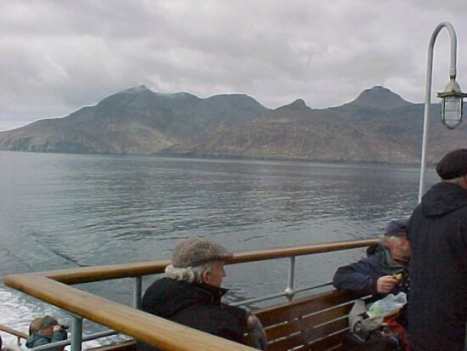
|
Rum from Waverley
|
Waverley off Eigg
|
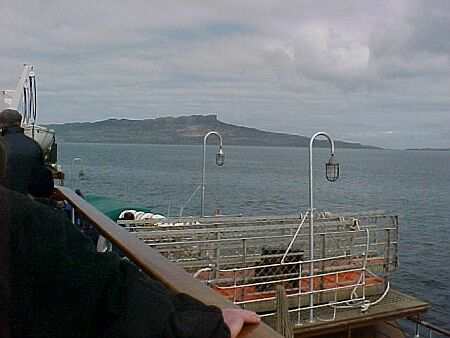
|
Waverley's fleetmate the motorship Balmoral had
negotiated these waters for the first time a year earlier when
she was en route to the farthest flung island of the group -
Canna. Waverley has never visited Canna and that was not her
destination on this occasion. Instead she headed east along the
southern shore of the misty isle of Skye. The mist was clearing
from the top of the awesome Black Cuillin ridge and the sun that
deserted us in the Sound of Mull returned. Below the Skye
mountains a little isle named Soay hid under the cliffs of her
larger neighbour.
It was on this lonely little isle that Waverley's
first master, Captain John Cameron, was born almost a century
ago. John Cameron had commanded Waverley's predecessor, the 1899
paddle steamer Waverley on the Firth of Clyde in the 1930s and
took the veteran vessel into her second period of National
Service under the White Ensign of the Royal Navy in 1939. John
Cameron was on the bridge of HMS Waverley when she rescued
hundreds of hapless Allied troops from the Nazi onslaught of
Dunkirk in 1940. Sadly the old Waverley was bombed and sunk as
she returned across the English Channel and many lives were lost.
Fortunately, John Cameron survived and seven years later he
proudly brought the new Waverley out to the Clyde. After a
lifetime of service on the Clyde steamers, John retired to the
west end of Glasgow but maintained his links our Waverley,
supporting her preservation and her predecessor, as President of
the Dunkirk Veterans' Association in Scotland. John passed away
just after Waverley's 40th anniversary but his contribution to
this famous ship is commemorated by a plaque erected to his
memory at the stairs to the bridge. In the modern parlance, the
lad from lonely Soay had 'done good'.
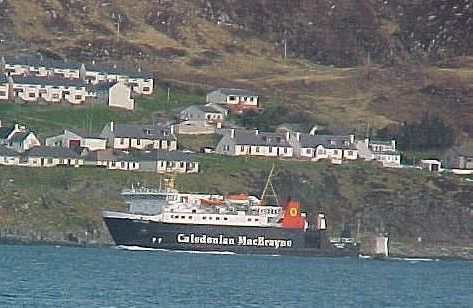 |
Waverley arrived at Armadale pier
just as the Caledonian MacBrayne ferry Lord of the Isles
was departing to cross over to the railhead at Mallaig
and Waverley's 600+ passengers (surely a record landing
from a single sailing ) streamed ashore for 90 minutes. |
| Some went to the beach to
photograph Waverley and the Lord of the Isles, a vessel
whose name revives memories of two magnificent paddle
steamers, built by the Glasgow shipyard of D & W
Henderson in 1877 and 1892 for service on the Clyde.
Other passengers visited the Clan Donald centre and the
unique Gaelic college Sabhal Mór Ostaig. |
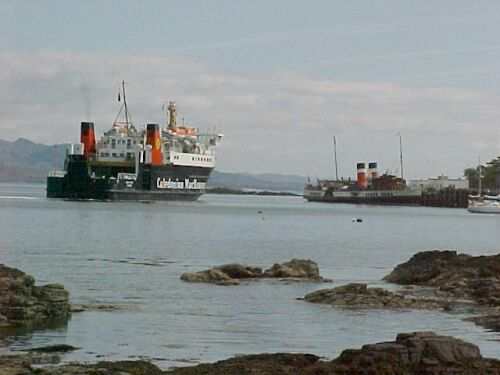 |
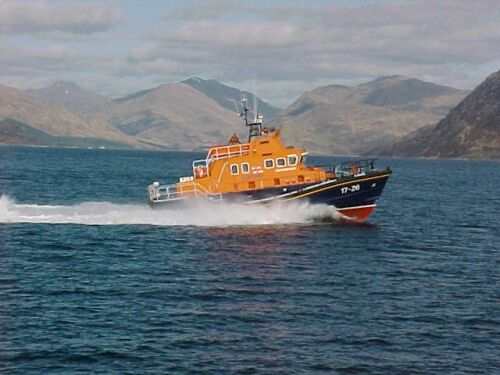 |
Just after 4.30 pm Waverley
pulled away from Armadale pier and headed across the
Sound of Sleat towards Mallaig where the local lifeboat
came out for a 'sail past'. To the north east the view
into Loch Nevis, dominated by the towering mountain
Ladhar Bheinn (Larven) was breathtaking - Loch Nevis -
loch of Heaven, indeed. |
| Just short of the harbour mouth
at Mallaigvaig Waverley turned south and headed for
Ardnamurchan, giving a close view of the famous
White Sands of Morar. |
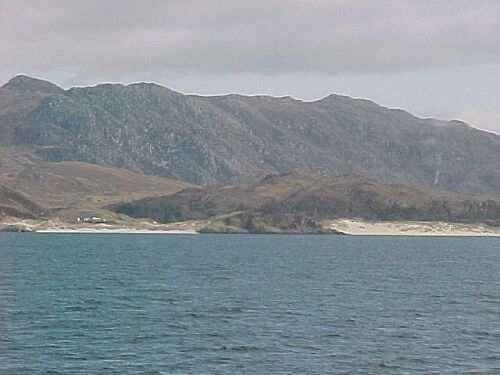 |
Back at Tobermory a large number of locals waited by
the pier to bid Waverley farewell. She responded with three long
blasts on her steam whistle as she left to paddle down the Sound
of Mull 'in the gloaming'. At dusk she arrived back at Oban North
Pier. Even then the long days was not over for Waverley's
dedicated engineroom crew. After a long days cruising they had
the task of bunkering the vessel between 10pm and 11pm in
preparation for her departure at 7 am next morning. No chance of
a late start for Sunday morning in this job!
Return to P.S. Waverley Home
Page











